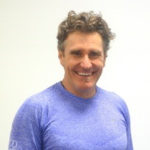Tom Myers New Zealand Tour
Body Play: Unravelling the Human Being


Enhance your client's experience by playing in the fascial network with Thomas Myers and Ian O'Dwyer.
Learn how to use the fascial properties
- viscosity
- elasticity
- plasticity
- remodelling
To increase power, reduce injuries, speed healing and recovery, and make training fun - fun for you, and fun for your clients. Learn to ‘listen’ to your fascia via the numerous sensory receptors, and 'speak' to your fascia through various types of movement training.
Join Ian and Tom for a rollicking tour of the Anatomy Trains Myofascial Meridians with author and bodyworker Tom Myers, and OD on Movement/PTA Global's, Ian O'Dwyer.
These two bat the ball back and forth between theory and practice, using totally involving and applicable exercises for creating fascial (and every other kind) fitness. Get your questions on fascia and fitness answered by experts with years in the trenches. Learn where your own 'blind spots' are and how to get them moving.
Workshop Agenda
- Connecting Techniques
- Therapy
- Application and Play
Anatomy Trains
One short course… long-lasting results for you!
Set your anatomy knowledge free! Thomas Myers’ Anatomy Trains® weekend intensives are holistic, fun and very useful. Completely transform your view of myofascial anatomy and expand your ability to assess your clients.
The Anatomy Trains concept moves beyond mechanical “cause and affect” actions of muscles to the integrative relational connections of real-life functional movement. This is a revolutionary map for analysing soft-tissue patterns, and developing strategies for unwinding these patterns via fascial and myofascial work.
Anatomy Trains offers skills that hands-on therapists, regardless of their modality, can use to see their clients more clearly and work more effectively.
Workshop Format:
The workshop is split into equal time on:
- Lecture/presentation,
- BodyReading™ and postural analysis, and
- fascial plane and myofascial plane techniques from Tom’s KMI Structural
- Integration and movement education library.
This course helps you:
- BodyRead your client’s postural and movement patterns with greater accuracy and integration
- Gain access to effective treatment strategies for resolving postural distortions, which may occur some distance from the site of pain or limitation
- Enable you to make distinct changes in your clients’ structure in a few short moves.
Course Objectives:
- Understand basic properties and connected nature of fascia, and tensegrity applied to fascia and human movement
- A succinct and relevant introduction to geometry/character of the connective tissue, and the topology of fascial planes
- Be able to identify and trace the 6 major and 6 supplemental fascial meridians along which movement, tension, and postural distortion travel
- Be able to BodyRead™ postural patterns based on analysis of Anatomy Trains lines
- Apply knowledge to construct a bodywork session appropriate for the specific pattern of each client
- This course also serves as a prerequisite for entry in the KMI 500-hour Certification Training
Learning Environment:
- Illustrated lecture
- Open inquiry atmosphere; questions encouraged; high degree of vitality and humour
- Participants will exchange palpation and practice BodyReading (visual assessment) on one another under supervised analysis of instructor and assistants
Fascial Release For Structural Balance: Head, Neck & Jaw
The FRSB workshops can be taken as stand alone workshops or as credits towards the full KMI training.
Course Description:
The Fascial Release for Structural Balance (FRSB) workshops are a set of intensive soft-tissue technique courses, divided into functional regions. Each course thoroughly conveys 15 – 20 technique ‘templates’, designed for versatile application for the different patterns your clients bring to you.
The neck is a remarkable feat of biomechanical engineering, giving a combination of a wide range of movement but maintaining a structural strength. It is often seen as the last site of compensation as it corrects for any alteration from below, allowing the eyes and ears to orient to the horizon. Patterns can of course work their way in the other direction, and particularly from the jaw and its many possible patterns of movement and holding. This course will focus on key areas of the neck and jaw complex to allow you to build successful strategies to ease these potential problem areas, alleviating the issues working in both directions and setting the body up for a longer lasting change.
Highlights include:
- The sub-occipital muscles.
- The laminar groove and deep cervical muscles.
- Soft-tissue techniques for shoulder muscles
- The muscular wires of the front of the neck – anterior scalenes and colli muscles.
- Intra-oral work for the hyoid complex, the tongue, and the floor of the mouth.
- The jaw muscles, TMJ, the palate and facial muscles.
Fascial Release for Structural Balance:
Fans of the Hip
The FRSB workshops can be taken as stand alone workshops or as credits towards the full KMI training.
Course Description:
The Fascial Release for Structural Balance (FRSB) workshops are a set of intensive soft-tissue technique courses, divided into functional regions. Each course thoroughly conveys 15 - 20 technique 'templates' designed for versatile application for the different patterns your clients bring to you.
Intrinsic Muscles of the Pelvis
The hip and pelvis combine to transfer the forces from two legs into the one spine, and therefore have a hugely complex role to fulfil in the body. Ida Rolf described the pelvis as 'the joint that determines symmetry' and it is easy to see why. Differences between the hips can affect down into the legs or up through the spine. Achieving balance here can be essential for long lasting results in any therapy. This course sheds light on the pelvis - the keystone of human architecture - by organising the 20 or so muscles of the pelvis into three fans. Get specific with sensitivity.
Objectives
- Seeing how the soft-tissue is arranged in an easy to understand pattern - the so-called 'fans' of the hip;
- Using these fans to balance pelvic tilts and torsions
- Learning how to work accurately, effectively and sensitively with the abductors around the ischial rams and deep lateral rotators, leading to the pelvic floor
- The psoas complex and the many variations on ideas of how it does (or does not) affect pelvic, low back and hip patterns
Each Class Includes:
- Relevant anatomy for the area - short intensive and integrated presentations assemble the best figures from multiple sources, including brand new learning tools such as video of fascial dissections and palpation of the relevant structures to convey the information in an inspiring and understandable fashion
- BodyReading (visual assessment) - the common postural and movement implications - how to see and 'read' them in the intricacy of individual patterns
- Fascial Release Techniques - each technique is fully laid out for intent and 'feel' with plenty of time for practice, ensuring that you can apply these methods immediately in your practice
